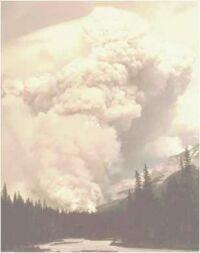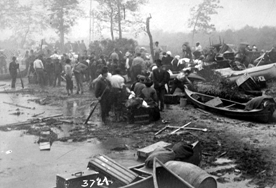Forest Fires Hazards
Billowing gray clouds of smoke, brilliant orange flames shooting 50 metres high, and then the blackened remains of trees in a sea of ashes. These are the images of wildfire in a forest. Striking with awesome power, a forest fire brings both destruction and renewal. Fire can be a threat to public health and safety, property and natural resources, but it also has an important role in maintaining the health and diversity of forest ecosystems.
 [D] [D]
Click for more information, 6 KB
Figure 1. Smoke plume, Vermilion Pass Fire, Kootenay National Park, British Columbia, 1968
On average, about 8500 forest fires are reported each year in Canada, burning an area of 2.5 million hectares. The area burned varies significantly from year to year for example, 0.3 million in 1978 to 7.5 million hectares in 1989 and from region to region. In comparison, the area harvested each year is about 1 million hectares. About 60% of forest fires are caused by humans, although a large majority in some regions is caused by lightning. Under a changing climate that could bring drier conditions and more severe weather events, forest fire activity is expected to increase.
Fire is a natural component of most forest ecosystems in Canada, as it has been for thousands of years. In remote northern areas and some national parks, many fires are allowed to burn until they are put out by rain or snow. But where there are more people and where timber has more commercial value, fires are aggressively suppressed. While the positive ecological aspects of fire are acknowledged, all fire management agencies have the protection of life and property as their top priority.
 [D] [D]
Click for more information, 12 KB
Figure 2. Fire Fighters on the Front Line
 [D] [D]
Click for more information, 7 KB
Figure 3. Air tankers can drop large amounts of water and fire-retardant foam
Operational forest fire management activities, such as fire suppression, prevention and prescribed burning, are the responsibility of the provincial/territorial governments and Parks Canada. Collectively, these agencies spend between $400 million and $800 million annually, making fire management one of the most expensive aspects of forest management in Canada. Challenges include:
- prevention (through education, fire danger notices, burning bans, fuel treatments and prescribed burning)
- early detection (from fire towers, aircraft and the public)
- effective preparedness and initial attack
- effective sustained attack if initial attack fails
- protecting people and their property and businesses (for example, through evacuations)
Very dry conditions, combined with high winds, can result in fire activity that cannot be stopped using current firefighting resources and technology. In such cases, fire fighting efforts focus on protecting any threatened homes or businesses until the weather changes and allows more direct suppression efforts.
 [D] [D]
Click for more information, 11 KB
Figure 4. Forest Aflame
Uncontrolled wildfires are of particular concern in the wildland-urban interface, which refers to areas where communities or human developments meet the forest or grassland. An ever-increasing number of people are living, working, camping and hiking in Canada's forests, making fire prevention and suppression increasingly important. Programs such as FireSmart address issues of safety and community protection.
Natural Resources Canada’s Canadian Forest Service, working with collaborators in fire management agencies and universities, has maintained an internationally recognized research program since the mid-1920s that has resulted in many innovations and new operational tools. The familiar colour-coded fire danger sign found in forested areas across Canada was developed under that program. More recently, it has produced the Forest Fires in Canada Web site with its interactive and other maps of daily fire conditions. Such programs and activities have contributed to the overall safety and well-being of Canadians, and to the sustainability of our forests. You can access this Web site in the References and Links section.
Impact of Wildfire
Forest Fire Costs and Deaths
In Canada, forest fires cost an enormous amount of money. On average, more than $400 millions is spent on fighting wildfires each year (1990–2001). In 1998, fire management costs were more than $800 million, and costs in 2003 were near $1 billion. The cost of a forest fire can far exceed that of the direct suppression cost. Other costs, such as loss of valuable timber and damage to private property or public infrastructure must be considered. Also, significant costs are involved in the evacuation of communities threatened by fire and in the disruptions to economic activity resulting from road and rail closures. Communities and businesses also suffer other less obvious economic losses for some time following a fire, but the total costs from a wildfire go largely unrecorded.
No civilian lives have been lost in Canada since the 1938 Dance Township fire in Ontario (which took 20 lives); however, between 1986 and 2005, a total of 34 fire management personnel were killed either by fires or in the process of fighting fires (for example, plane crashes).
Table 1. Fatalities from Forest Fires
Fatalities from Forest Fires
| 1986 |
6 |
| 1987 |
3 |
| 1988 |
3 |
| 1989 |
0 |
| 1990 |
3 |
| 1991 |
4 |
| 1992 |
2 |
| 1993 |
0 |
| 1994 |
2 |
| 1995 |
4 |
| 1996 |
0 |
| 1997 |
0 |
| 1998 |
0 |
| 1999 |
0 |
| 2000 |
0 |
| 2001 |
2 |
| 2002 |
0 |
| 2003 |
3 |
| 2004 |
2 |
| 2005 |
0 |
|
Source : Johnston, Tom. Canadian Interagency Forest Fire Centre, Canada Report 2006.
Mitigation and Vulnerability
Canadians live, work and play throughout the forested regions of the country and take advantage of resource-based economies, employment opportunities and recreational activities. However, the risk of wildfire to homes and communities can be significant, and Canada has a long history of evacuations and property destruction caused by wildfire events.
Although fire will always have a major impact on much of Canada’s forests, mitigation activities such as education, fuel management, and good building and development practices can dramatically decrease the probability of losses to public and private infrastructure.
There are a number of simple and affordable methods to help homeowners reduce the risk associated with living in forested areas. These include clearing vegetation from around the home, building with fire-resistant materials, and identifying and dealing with risks before fire occurs. Programs such as FireSmart address issues of safety and community protection. You can access this Web site in the ’References and Links’ section.
 [D] [D]
Click for larger version, 141 KB
Figure 5. FireSmart
Community protection requires a long-term, multidisciplinary approach to reduce the risk of forest fire damage or loss. Public education, emergency response planning, hazard assessment and land-use planning can all make a difference. Community protection is about minimizing the negative impact of fire on a community and preparing efficient and effective community responses when fires occur.
For more information about protecting your home and community, visit the “Partners in Protection” Web site and the Public Safety Canada Web site “Is your Family prepared?” listed in the References and Links section. The latter has excellent advice on what to include in both an emergency plan and an emergency kit - these can be put to good use in any natural disaster or emergency.
Case Studies
British Columbia, 2003
 [D] [D]
Click for larger version, 190 KB
Figure 6. Cluster of homes destroyed by the Okanagan Mountain Park fire in the summer of 2003
The summer of 2003 was the worst ever for forest fires in British Columbia. Abnormally hot, dry weather resulted in over 2500 wildfire starts over a vast area, mostly in the interior of the province. Interface fires, which occur in places where wildland meets urban development, were at an all-time record high.
The interface fires of that summer destroyed over 334 homes and many businesses, and forced the evacuation of over 45 000 people. The total cost of the firestorm is estimated at $700 million. The greatest cost of all was the loss of the lives of three pilots who died in the line of duty.
British Columbians can consider themselves fortunate that the disaster was not worse. Few communities in the province would have been immune from an interface fire, given the extreme danger ratings over the course of the summer. Without action, the danger remains.
Chisholm, Alberta, 2001
 [D] [D]
Click for more information, 22 KB
Figure 7. Chisholm, Alberta, 2001
The Chisholm fire, which began near a CN Rail line on May 23, 2001, destroyed 10 homes, a trapper’s cabin, 48 outbuildings and some vehicles, mostly in the hamlet of Chisholm, about 150 kilometres north of Edmonton (located in the municipal district of Lesser Slave River No. 124). There were no human lives lost in this fire.
Wind and dry conditions created extreme fire behaviour in the Chisholm fire, burning approximately 116 000 hectares of land – an area three times the size of the City of Edmonton.
The fire severely impacted the Hamlet of Chisholm through loss of property and disruption in the lives of residents. Additionally, the forest industry lost some 4.5 million cubic metres of growing stock and more 6300 hectares of regenerated cutblocks. The area’s oil and gas industry, railway and electrical infrastructure also experienced substantial losses.
Chapleau-Mississagi, Northeastern Ontario, 1948
 [D] [D]
Click for more information, 22 KB
Figure 8. Chapleau-Mississagi, Northeastern Ontario, 1948
The Chapleau-Mississagi fire, which occurred during the months of May and June 1948, began as a result of human carelessness. The fire burned some 280 000 hectares between the towns of Thessalon and Chapleau, and had a dramatic effect on the forest industry in the region. Smoke from the fires caused the lights to come on during the daytime in several Texas cities and choked residents from Ontario to the United States Gulf coast with acrid, nose-biting fumes.
Efforts to contain the fires were hampered by highly flammable balsam fir and white spruce stands that had been killed by spruce budworm, coupled with strong winds, high temperature Protection Program, British Columbia Ministry of Forests and Range., low relative humidity and four weeks without rain.
Miramichi, near Fredericton, New Brunswick, 1825
 [D] [D]
Click for larger version, 318 KB
Figure 9. Miramichi, near Fredericton, New Brunswick, 1825
The Miramichi fire, which occurred in October 1825, is the largest known fire in eastern North America.
The fire burned more than 1 million hectares in New Brunswick and Maine, and 280 to 300 lives were lost. The fire originated from several smaller fires caused by humans, and was preceded by a very dry summer.
Porcupine, Northern Ontario, July 11, 1911
 [D] [D]
Click for more information, 39 KB
Figure 10. Porcupine, Northern Ontario, July 11, 1911
The Porcupine fire, which started on July 11, 1911, was one of the most catastrophic fires ever to occur in Ontario. The fire burned an estimated 200 000 hectares, killed at least 70 people and destroyed several mining camps and communities in the area.
For more information on these case studies, visit the ’References and Links’ section.
Now, that you have read about forest fires, try our quiz!
|
